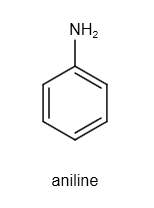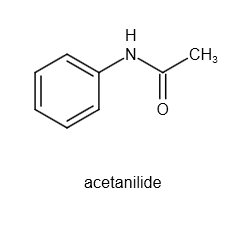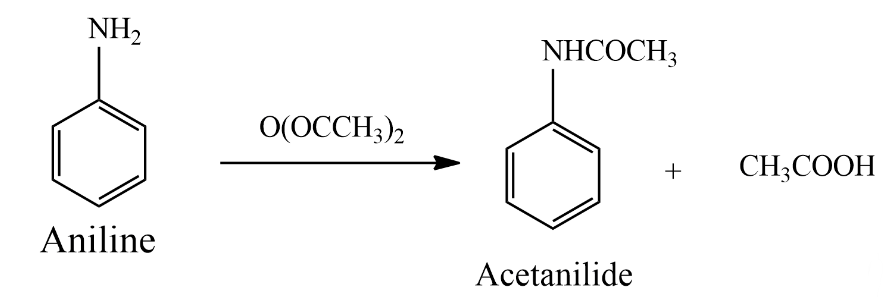
\[1.86\,g\] of aniline completely reacts to form acetanilide. \[10\% \] of the product is lost during purification. Amount of acetanilide after purification (in g) is ________\[ \times {10^{ - 2}}\].
Answer
223.8k+ views
Hint: There is \[1.86\,g\] of aniline is given. For solving this question, we have to calculate the molar mass of aniline and acetanilide. The structure of aniline is as follows:

Image: Structure of aniline
The structure of acetanilide is as follows:

Image: Structure of acetanilide
These structures are useful to understand the conversion of aniline to acetanilide.
Complete Step by Step Solution:
For calculating the amount of acetanilide obtained, we have to calculate the molar mass of aniline and acetanilide.
The chemical formula of aniline is \[{C_6}{H_7}N\] .
Let us calculate the molar mass of aniline as follows:
$ {\text{molar mass of aniline}} = 6\left( {12} \right) + 7\left( 1 \right) + 1\left( {14} \right) \\$
$ \Rightarrow {\text{molar mass of aniline}} = 93 \\ $
Therefore, the molar mass of aniline is 93.
The chemical formula of acetanilide is \[{C_8}{H_9}NO\] .
Let us calculate the molar mass of acetanilide as follows:
$ {\text{molar mass of acetanilide}} = 8\left( {12} \right) + 9\left( 1 \right) + 1\left( {14} \right) + 1\left( {16} \right) \\$
$ \Rightarrow {\text{molar mass of acetanilide}} = 135 \\ $
Therefore, the molar mass of acetanilide is 135.

Image: Chemical reaction for preparation of acetanilide
From the reaction stoichiometry, one-mole aniline produces one mole of acetanilide.
Now, by using molar mass we can say that,
\[93\,g\] aniline produces \[135\,g\] acetanilide.
Let us calculate that acetanilide produces by \[1.86\,g\] of aniline as follows:
$ {\text{amount of acetanilide}} = 1.86 \times \dfrac{{135}}{{93}} \\$
$ \Rightarrow {\text{amount of acetanilide}} = 2.7\,g \\ $
Therefore, there is \[2.7\,g\] of acetanilide produced.
But \[10\% \] of the product is lost during purification. Therefore, there is \[90\% \] product formed.
Let us calculate the actual product as follows:
$ {\text{actual amount of acetanilide}} = 2.7 \times \dfrac{{90}}{{100}} \\$
$ \Rightarrow {\text{actual amount of acetanilide}} = 2.43\,g \\$
$ \Rightarrow {\text{actual amount of acetanilide}} = 243 \times {10^{ - 2}}\,g \\ $
As a result, there is \[243 \times {10^{ - 2}}\,g\] of acetanilide produced in the reaction.
Therefore, correct answer is \[243\] .
Note: Acetanilide is a carcinogenic substance that can lead to cancer in people. During the fractional distillation of acetic anhydride, avoid inhaling the vapours. Continue to boil the mixture vigorously while stirring in the ice-cold water. Because of the amide group, acetanilide is a polar molecule. Antifebrin was the brand name for a drug that was once used to treat fever and headaches.

Image: Structure of aniline
The structure of acetanilide is as follows:

Image: Structure of acetanilide
These structures are useful to understand the conversion of aniline to acetanilide.
Complete Step by Step Solution:
For calculating the amount of acetanilide obtained, we have to calculate the molar mass of aniline and acetanilide.
The chemical formula of aniline is \[{C_6}{H_7}N\] .
Let us calculate the molar mass of aniline as follows:
$ {\text{molar mass of aniline}} = 6\left( {12} \right) + 7\left( 1 \right) + 1\left( {14} \right) \\$
$ \Rightarrow {\text{molar mass of aniline}} = 93 \\ $
Therefore, the molar mass of aniline is 93.
The chemical formula of acetanilide is \[{C_8}{H_9}NO\] .
Let us calculate the molar mass of acetanilide as follows:
$ {\text{molar mass of acetanilide}} = 8\left( {12} \right) + 9\left( 1 \right) + 1\left( {14} \right) + 1\left( {16} \right) \\$
$ \Rightarrow {\text{molar mass of acetanilide}} = 135 \\ $
Therefore, the molar mass of acetanilide is 135.

Image: Chemical reaction for preparation of acetanilide
From the reaction stoichiometry, one-mole aniline produces one mole of acetanilide.
Now, by using molar mass we can say that,
\[93\,g\] aniline produces \[135\,g\] acetanilide.
Let us calculate that acetanilide produces by \[1.86\,g\] of aniline as follows:
$ {\text{amount of acetanilide}} = 1.86 \times \dfrac{{135}}{{93}} \\$
$ \Rightarrow {\text{amount of acetanilide}} = 2.7\,g \\ $
Therefore, there is \[2.7\,g\] of acetanilide produced.
But \[10\% \] of the product is lost during purification. Therefore, there is \[90\% \] product formed.
Let us calculate the actual product as follows:
$ {\text{actual amount of acetanilide}} = 2.7 \times \dfrac{{90}}{{100}} \\$
$ \Rightarrow {\text{actual amount of acetanilide}} = 2.43\,g \\$
$ \Rightarrow {\text{actual amount of acetanilide}} = 243 \times {10^{ - 2}}\,g \\ $
As a result, there is \[243 \times {10^{ - 2}}\,g\] of acetanilide produced in the reaction.
Therefore, correct answer is \[243\] .
Note: Acetanilide is a carcinogenic substance that can lead to cancer in people. During the fractional distillation of acetic anhydride, avoid inhaling the vapours. Continue to boil the mixture vigorously while stirring in the ice-cold water. Because of the amide group, acetanilide is a polar molecule. Antifebrin was the brand name for a drug that was once used to treat fever and headaches.
Recently Updated Pages
JEE General Topics in Chemistry Important Concepts and Tips

JEE Extractive Metallurgy Important Concepts and Tips for Exam Preparation

JEE Atomic Structure and Chemical Bonding important Concepts and Tips

JEE Amino Acids and Peptides Important Concepts and Tips for Exam Preparation

Electricity and Magnetism Explained: Key Concepts & Applications

JEE Energetics Important Concepts and Tips for Exam Preparation

Trending doubts
JEE Main 2026: City Intimation Slip Releasing Today, Application Form Closed, Exam Dates, Syllabus & Eligibility

JEE Main 2026 Application Login: Direct Link, Registration, Form Fill, and Steps

Understanding the Angle of Deviation in a Prism

How to Convert a Galvanometer into an Ammeter or Voltmeter

Ideal and Non-Ideal Solutions Explained for Class 12 Chemistry

Hybridisation in Chemistry – Concept, Types & Applications

Other Pages
JEE Advanced Marks vs Ranks 2025: Understanding Category-wise Qualifying Marks and Previous Year Cut-offs

JEE Advanced 2026 - Exam Date (Released), Syllabus, Registration, Eligibility, Preparation, and More

JEE Advanced 2026 - Exam Date (Released), Syllabus, Registration, Eligibility, Preparation, and More

Organic Chemistry Some Basic Principles And Techniques Class 11 Chemistry Chapter 8 CBSE Notes - 2025-26

Hydrocarbons Class 11 Chemistry Chapter 9 CBSE Notes - 2025-26

Redox Reaction Class 11 Chemistry Chapter 7 CBSE Notes - 2025-26




